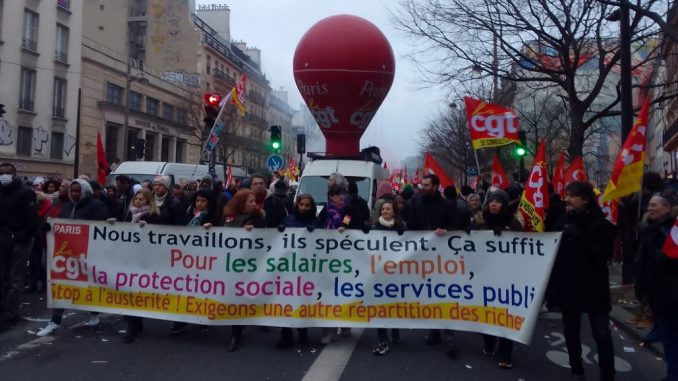
According to the governme4nt itself, on January 19 there were more than a million people mobilized throughout the country against said reform, which in reality is anti-retirement. According to the CGT and other union organizations, there were more than two million. Even with an average of the numbers, it was undoubtedly a huge mobilization, and together with the strike made a strong impact. Thus, the first round of this tough wrestling was won by the working people and lost by Macron, the political sectors that support him and the employers.
By Pablo Vasco
There is always debate about the numbers. Regarding the march in Paris, for example, which covered some 30 blocks from the République to the Nation, the Minister of Interior speaks of 80,000 demonstrators while the trade union federations counted 400,000… But in France no one is fooled. All the major media had to recognize that the mobilization was an obvious success. What’s more: another route had to be opened so that the columns could get underway. This massive turnout was repeated throughout the interior of France. The streets confirmed what the polls had been indicating: the rejection of the reform of the pension system is between 60 and 70% of the so-called public opinion.
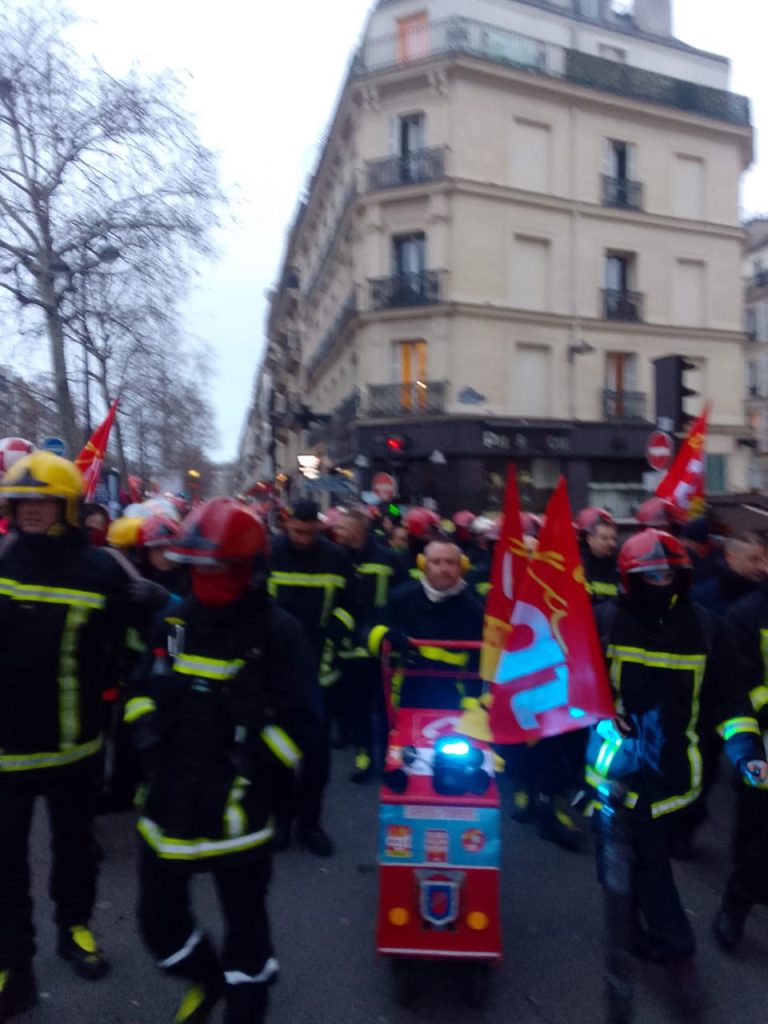

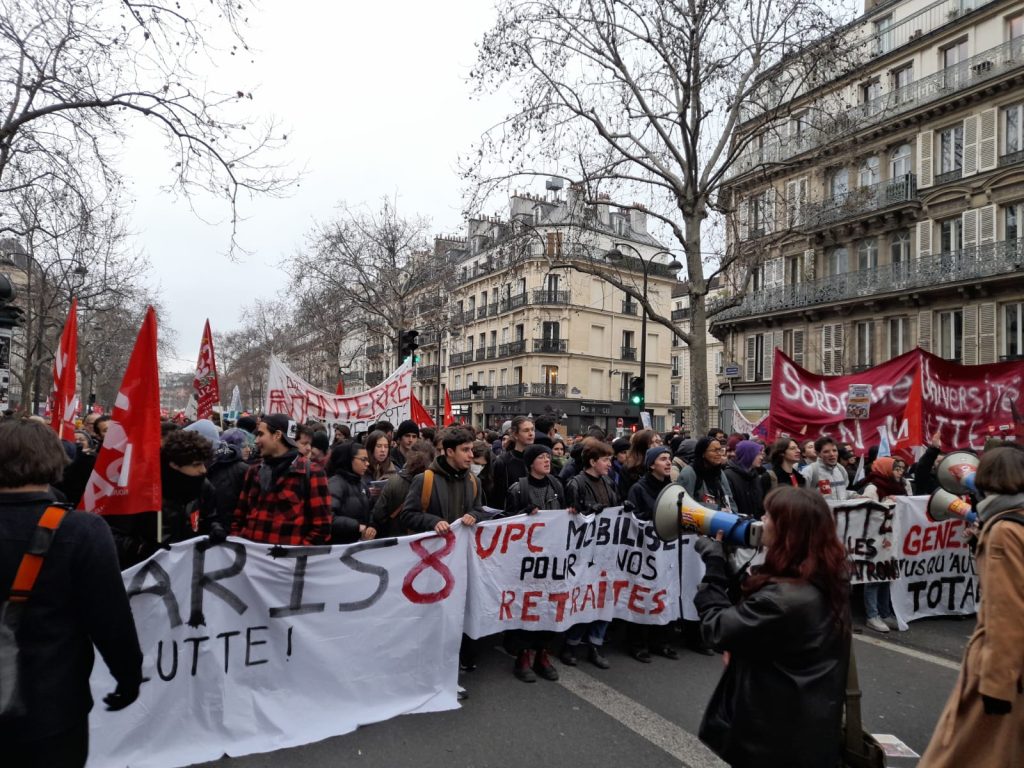
In the case of Paris, the largest columns were those of the workers organized in the CGT and its various branches. Then, the SUD-Solidaires, Workers’ Force, the CFDT, the UNSA and others. Teachers, nurses, social workers were also present, as well as workers from private companies. And although they are just resuming classes, the university and high school student organizations made their militant contribution. But what was notorious was the presence of thousands and thousands of people who joined in independently, alone or in small groups. And for many of them, it was their first march. The left and extreme left parties did not set up their own columns, but their banners, stands and leaflets were seen throughout the march, including the revolutionary wing of the NPA, where the comrades of the ISL in France are militants.
In the case of Paris, the largest columns were those of the workers organized in the CGT and its various branches. Then, the SUD-Solidaires, Workers’ Force, the CFDT, the UNSA and others. Teachers, nurses, social workers were also present, as well as workers from private companies. And although they are just resuming classes, the university and high school student organizations made their militant contribution. But what was notorious was the presence of thousands and thousands of people who joined in independently, alone or in small groups. And for many of them, it was their first march. The left and extreme left parties did not set up their own columns, but their banners, stands and leaflets were seen throughout the march, including the revolutionary wing of the NPA, where we comrades of the ISL in France operate.
As for the strike, launched a little more than a week earlier, it was generally partial. Three union sectors were clearly at the forefront, with high strike percentages of between 60 and 80%: energy workers and oil refineries and related industries, who months ago had a strong wage strike; teachers at all levels, and transport workers, whose special pension system is directly threatened by the reform. In Paris and its suburbs there were almost no buses and only two of the 16 subway lines operated partially. Of the local, regional and high-speed trains, on average, only one in four or less was in operation.
On the other side, the day of struggle had one big absence: while the working people occupying the streets from one end of France to the other, Macron was in Spain signing a “friendship deal.” Provoking, from Barcelona he declared “the reform will be done,” which confirms the hardness of the wrestling that has begun. He is the one blocking the country with his anti-worker and anti-popular reform.
What does the reform consist of?
- Raising the retirement age from the current 62 years to 64 years in 2030.
- Raise the years of full contributions, that is, without partial or precarious employment or unemployment, from the current 41.5 years to 43 years in 2027.
- If they do not meet this requirement, they will receive less than the full minimum pension or will have to work until the age of 67 to receive it.
- Eliminate almost all special pension regimes, including those in sectors with unsanitary tasks (transportation, electricity, gas).
The government’s excuse is the “growing deficit of the funds” and “intergenerational solidarity”. But apart from the fact that so far there is no such deficit, if salaries were increased by 5%, contributions to the funds would automatically increase in the same proportion, which would be enough to cover the supposed shortfall estimated for 2032. And this without increasing employer contributions, a measure that would be necessary. In the capitalist profits and big fortunes there is plenty of money to collect and allocate to solve the social deficits.
“Solidarity” is also false. The government and the capitalists apply austerity measures on the working class from start to finish and even more at both ends of the career: young people are more flexibilized, more precarious and worse paid than a worker with seniority, who in turn is fired, becomes unemployed and then receives less than the minimum pension or must work more years to collect it. In short, they have to work until they are bursting at the seams, without being able to enjoy their old age as it should be.
As the leaflet we distributed says, “years of hardship at both ends of active life, miserable pensions and wage cuts is the triple recipe of the government and the employers”.
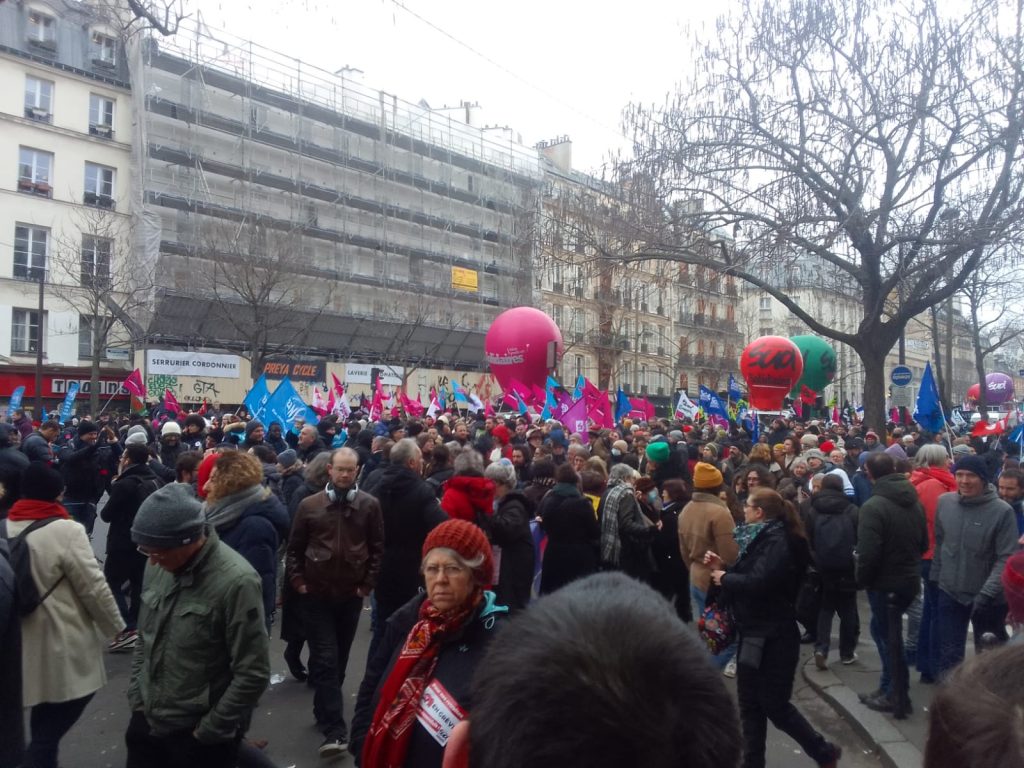
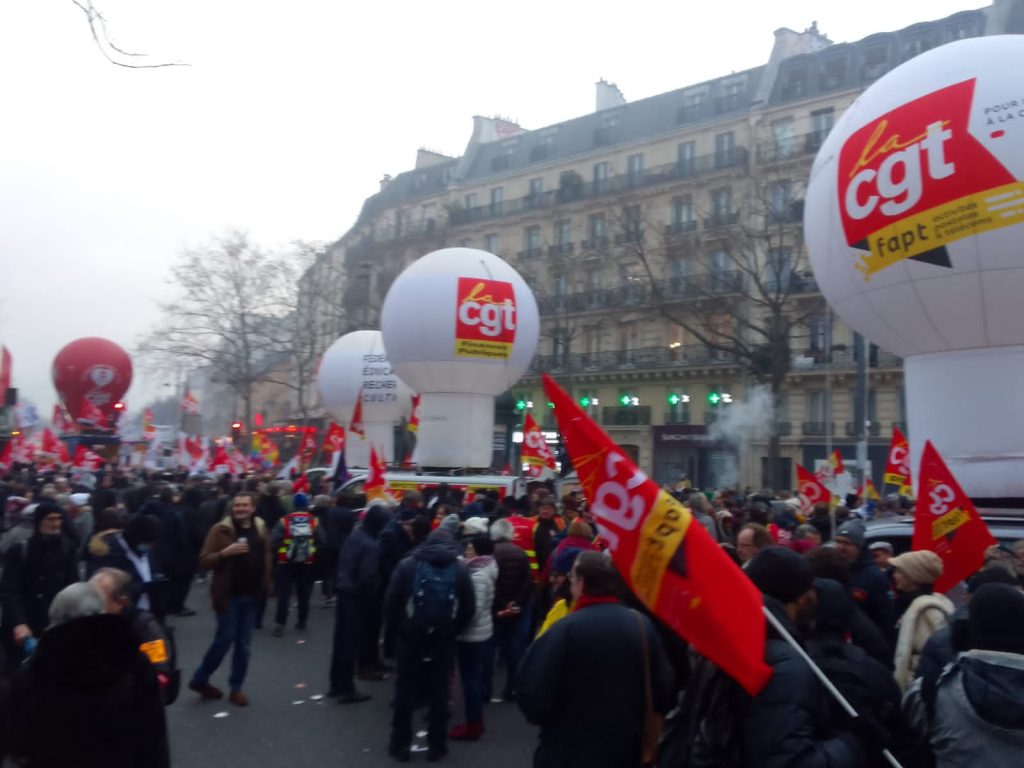
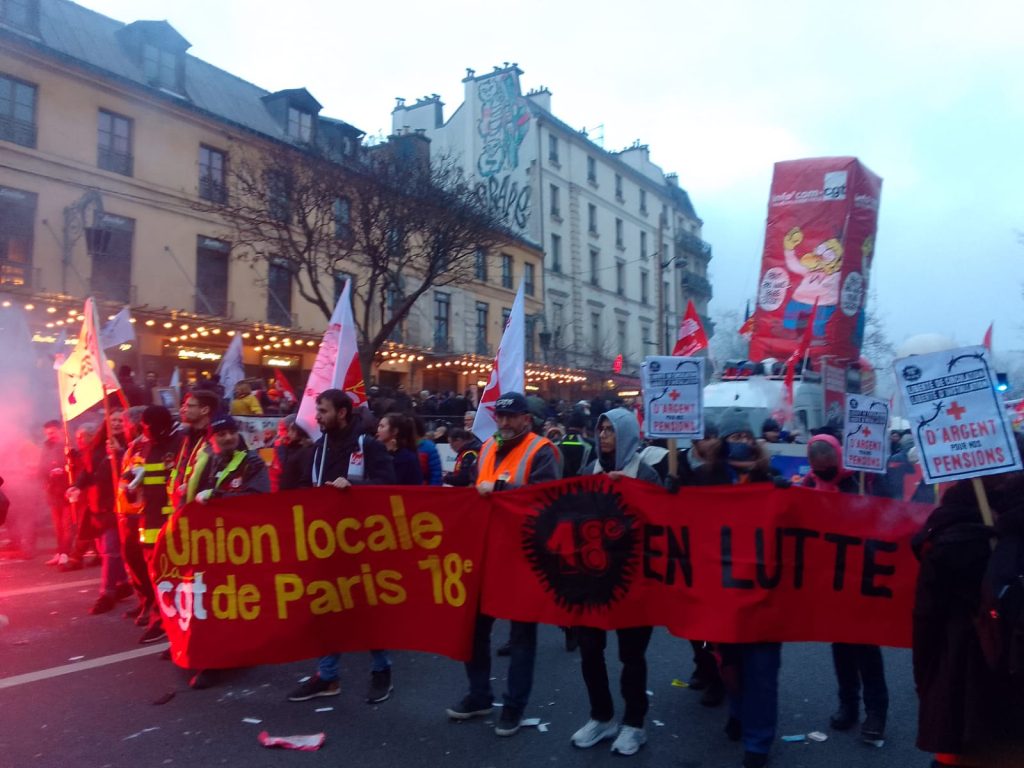
There are more reasons to go out to fight
In addition to the problem of the pension reform, there are other problems that fuel popular anger. The first is the continuous loss of the purchasing power of wages in the face of inflation, especially in basic necessities. For this reason, the wage demands, often including indexation, have been the main driving force of the struggles of recent times.
There is also the problem of the increasingly worse and more tiring working conditions. In sectors such as education, health, social assistance and other public services, such conditions are increasingly distressing, as staff shortages and growing social demands imply overwork for effective workers.
If before this reform the government already cut subsidies to the unemployed, froze employment in the public sector and pushed all wages down, if its reform passes the capitalist attack will deepen as a whole. On the contrary, if this reform of Macron and the bourgeoisie is defeated we will be in much better conditions to recover our rights and advance. And it can be won!
What continuity is foreseen?
This Saturday 21 there will be another day of national mobilization, called by an arc of youth organizations ranging from France Insumisa-NUPES to the far-left. Of course, it is necessary to participate. This does not remove internal frictions within the NUPES, as for example the PC, which instead of promoting the march proposes to call for a referendum… There will also be actions on the 23rd, when the project will be presented to the Council of Ministers.
On the very night of the 19th, following the success of the demonstrations, the Inter-Union which groups all the trade union federations -which is already a significant fact in itself- has called for a new 24-hour strike and mobilization for January 31, the day after the reform bill begins to be debated in the parliamentary commissions.
But in view of the risk of distant strikes, which are deflating the struggle, a legitimate pressure to go further has begun from below. For example, the refinery workers of the CGT-Oil are calling for a 48-hour strike on January 26-27 and another 72-hour strike as from February 6, the date foreseen for the debate in the House of Representatives, in order to then propose a strike for an indefinite period of time. From other workplaces the demand for continuity also arises, although up to now most of the assemblies have been small.
But the leadership of this transcendental battle should not remain in the exclusive hands of the union bureaucracy, always ready to “dialogue” and make pacts with the government and the bosses. The strike belongs to the strikers and this struggle belongs to the whole working class and the youth. It is key to organize general assemblies from the base in each workplace, to demand from the union leaderships the continuity of a real plan of struggle and the indefinite general strike until the definitive withdrawal of the reform and to impose at the same time a general increase in wages, pensions and social benefits. Also to promote assemblies and actions in the student movement, as well as instances of coordination among the sectors in struggle.
Struggle and political perspective
Macron attacks relentlessly. The Republicans support him. Marine Le Pen “opposes” the reform, but she will not “obstruct” it, so she will let it pass. And the NUPES opposes the reform and mobilizes a little, but its axis remains the parliamentary dispute, which is a dead end because the whole institutional regime of the Fifth Republic are at the service of the interests of the ruling class.
If Macron is gambling on parliamentary approval, precisely the key to the arm wrestling is in the streets. But confronting the reform and the whole austerity plan of the government does not imply only a trade union matter, but also a political one. That is why, together with promoting the struggle, it is necessary to strengthen a revolutionary pole that, as a way out of the crisis, proposes structural changes, without any compromise with the capitalists, their politicians and institutions.
In this sense, and considering that only the far-left has this objective of anti-capitalist and socialist transformation, we invite you to the act of struggle and political alternative that the revolutionary wing of the NPA is calling for Saturday, February 8, in Paris, at La Bellevilloise, in the framework of other acts that are being prepared in the main cities of France.








